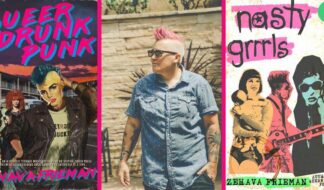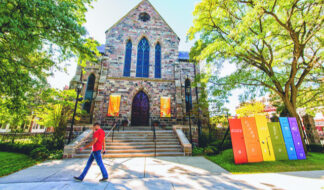BY DANA RUDOLPH
Stories have power. Two new collections of stories about the creation of LGBTQ families reinforce that point with two very different approaches.
"Modern Families: Stories of Extraordinary Journeys to Kinship," by Joshua Gamson (NYU Press: 2015) is a collection of creation tales about Gamson's own family and several other LGBTQ families that he knows, woven together by insights on the meaning of families today and the intersecting and sometimes conflicting social, legal and economic contexts in which we create them.
Gamson, a professor of sociology at the University of San Francisco, was motivated to write, he says, by people inquiring about his own family. Gamson, White and Jewish, and his biracial (black and white) husband Richard had one child with a friend of Gamson's as their surrogate, and eggs from another friend. For their second child, they used a surrogate from an agency and eggs donated by a friend. While he sometimes bristled at questions about his family, he realized, "People really just wanted to know about origins: how a life and a family started when not everything was easy and scripted."
He was surrounded by such stories. In his immediate social circle were a single mother by choice who adopted a child from Ethiopia; a lesbian couple who used one woman's eggs while the other carried the fetus, fertilized from donor sperm; another lesbian couple co-parenting two adopted children (from Nepal and India) with a gay male couple; and a couple consisting of a woman and a transgender man, who started a family through private adoption.
He shares their tales with an engaging, gently humorous, and at times poetic style. At the same time, he also teases out the connections between individual family stories and the social systems in which they are immersed. "There is no separation between the ways we make our families and the various social hierarchies in which we all find ourselves," he says. His goal is not a systematic study, but rather an exploration of how these hierarchies — of gender, ethnicity, race and class — may affect our family-making and are illuminated by it in turn. Often-expensive assisted reproduction, for example, "facilitates the creation of some queer families even as it reinforces the distance between haves and have-nots."
This is not an "academic" book, however, despite Gamson's credentials. (It should not be confused with "Modern Families: Parents and Children in New Family Forms," by Susan Golombok, also published last year and a worthwhile overview of current academic research.) Gamson places his book between what he calls "repro lit" — personal, honest accounts of starting families — and "repro crit," often critical academic analyses of the institutional structures of family creation. The stories of the parents in his book, he says, cannot be understood outside their structural context but also cannot be understood apart from the personal, intense, creative drive that motivated them to become parents in the first place. His deft blending of the two makes his book a must-read for anyone interested in families today.
In Their Own Words
This brings us to "Journey to Same-Sex Parenthood: Firsthand Advice, Tips and Stories from Lesbian and Gay Couples," by Eric Rosswood (New Horizon Press: 2016) which lies more towards the "repro lit" end of the spectrum. It features stories of 19 couples (and co-parenting units of more than two) telling us in their own words about the obstacles and triumphs of forming their families. A list of legal tips and questions to ask in choosing a parenting path add to its practical, how-to feel.
We meet parents from around the U.S., as well as the U.K., Ireland and South Africa. Their conversational and candid essays are grouped by type of family formation: Open Adoption, Foster Parenting and Adopting from Foster Care, Surrogacy and Assisted Reproduction. Rosswood explains that he wanted to include all these approaches in one volume to help others who are starting their parenting journeys but unsure which way to go. After reading through these stories, prospective parents should indeed have a better sense of what's involved with each method and be better prepared to make their own decisions.
For each section, Rosswood provides a brief overview of what each path to parenthood involves. The section on "Open Adoption," however, is misleading. His introduction there implies that all open adoptions begin with the birth of the child. All of the stories in that section do involve parents who adopted newborns, but the fact is, open adoptions — which allow some form of association among the adoptive parent(s), birth parent(s) and child — can occur with children adopted at any age, as well as with those adopted from foster care (whom Rosswood puts in a different section). The section would have been better titled "Infant Adoption."
Nevertheless, many same-sex couples considering parenthood will find the first-person stories in this book immediately useful, both for their practical tips and for the comforting sense they convey that others have been there before.
Those seeking insight on how we LGBTQ families fit into larger social systems, however, but who want something more personable than an academic study, should turn to Gamson, who gives us thoughtful proof that the personal is indeed political.
"Hyperintentional, inventive and obstinate, the families wrote their own scripts," he says. The stories in both books help us to better understand–and to be part of–that creative process.









